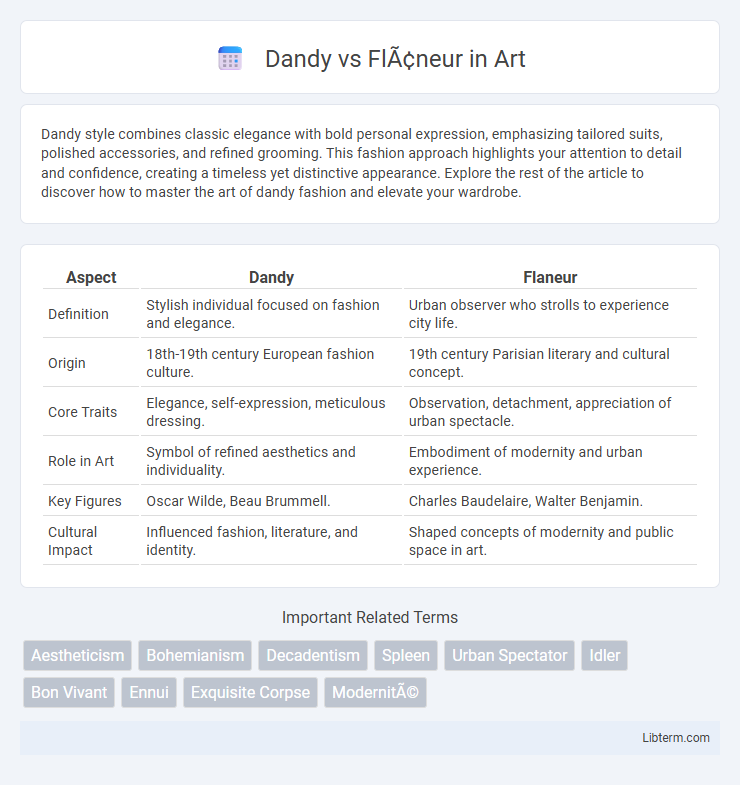Dandy style combines classic elegance with bold personal expression, emphasizing tailored suits, polished accessories, and refined grooming. This fashion approach highlights your attention to detail and confidence, creating a timeless yet distinctive appearance. Explore the rest of the article to discover how to master the art of dandy fashion and elevate your wardrobe.
Table of Comparison
| Aspect | Dandy | Flaneur |
|---|---|---|
| Definition | Stylish individual focused on fashion and elegance. | Urban observer who strolls to experience city life. |
| Origin | 18th-19th century European fashion culture. | 19th century Parisian literary and cultural concept. |
| Core Traits | Elegance, self-expression, meticulous dressing. | Observation, detachment, appreciation of urban spectacle. |
| Role in Art | Symbol of refined aesthetics and individuality. | Embodiment of modernity and urban experience. |
| Key Figures | Oscar Wilde, Beau Brummell. | Charles Baudelaire, Walter Benjamin. |
| Cultural Impact | Influenced fashion, literature, and identity. | Shaped concepts of modernity and public space in art. |
Defining the Dandy: Origins and Characteristics
The dandy originated in the late 18th and early 19th centuries as a cultural figure defined by an obsession with style, elegance, and refined self-presentation, epitomized by iconic figures like Beau Brummell. Characterized by meticulous grooming, exaggerated manners, and a deliberate display of sophistication, the dandy sought to distinguish himself from mainstream society through aesthetic and social performance. Unlike the flaneur, who embraces casual urban exploration and detached observation, the dandy's identity hinges on curated appearance and conscious social distinction.
The Flâneur: History and Evolution
The Flaneur originated in 19th-century Paris as a leisurely urban explorer who embodied the spirit of modernity by observing city life with detached curiosity. Evolving through literary and cultural interpretations, the Flaneur became a symbol of the modern observer, experiencing the anonymity and rhythm of urban spaces in works by Charles Baudelaire and Walter Benjamin. This figure contrasts with the Dandy by emphasizing communal engagement and reflective wandering rather than personal style and flamboyance.
Key Differences Between Dandy and Flâneur
The key differences between a Dandy and a Flaneur lie in their social roles and motivations; a Dandy emphasizes refined personal style and elegance as a statement of individuality and social status, while a Flaneur adopts a detached, observant stance to explore urban life and modernity. Dandies often engage in deliberate self-presentation and fashion innovation, reflecting a performative identity, whereas Flaneurs are characterized by their leisurely, contemplative urban wandering and deep engagement with the city's rhythms and social dynamics. These distinctions highlight contrasting approaches to self-expression and interaction with the public sphere in 19th-century metropolitan culture.
Fashion and Aesthetics in Dandyism
Dandyism epitomizes a meticulous approach to fashion and aesthetics, emphasizing refined tailoring, unique accessories, and an elegant, polished appearance that challenges conventional masculinity. The dandy's style is a deliberate performance, showcasing individuality through carefully curated clothing that blends boldness with sophistication. In contrast, the flaneur engages with urban life more passively, focusing on observation rather than sartorial display, making fashion a critical distinguishing element in understanding dandy identity.
Observation and Urban Strolling: The Flâneur’s World
The flaneur epitomizes the art of urban strolling, observing city life with a detached, contemplative gaze that captures the vibrant spirit and subtle rhythms of the metropolis. Unlike the dandy, whose focus lies in refined appearance and social distinction, the flaneur immerses in the sensory details of streetscapes, architecture, and crowds, transforming everyday urban scenes into living narratives. This mode of observation reveals the city as a dynamic canvas, where anonymity and movement create a space for endless discovery and poetic insight.
Cultural Impact: Dandy vs Flâneur
The dandy epitomizes refined elegance and self-expression through fashion, shaping cultural standards of masculinity and style in 19th-century Europe. The flaneur represents the urban observer, influencing modern theories of urban sociology and visual culture by embodying the art of casual, detached city wandering. Both figures significantly impacted literature, art, and social critique, with the dandy emphasizing individualism and the flaneur highlighting the experience of modern urban life.
Dandyism in Literature and Art
Dandyism in literature and art embodies a cultivated aesthetic of elegance and refined appearance, often symbolizing rebellion against societal norms through meticulous fashion and wit. Figures like Oscar Wilde and Baudelaire popularized dandyism as an artistic expression, blending style with intellectual and cultural critique. This movement emphasizes individuality and self-presentation as performative acts, influencing portraiture, poetry, and prose with its distinctive blend of irony and sophistication.
The Flâneur in Modern Society
The Flaneur in modern society embodies the urban wanderer, observing city life with detached curiosity and reflective insight. This figure represents a critical perspective on contemporary urbanism, emphasizing the experience of public spaces as sites of cultural and social interaction. The Flaneur's role highlights the importance of slow, mindful engagement with the environment in contrast to the fast-paced, consumer-driven lifestyle prevalent today.
Social Status and Identity: Dandy and Flâneur Perspectives
The dandy cultivates an elevated social status through meticulous fashion and refined manners to assert individuality and aristocratic identity. In contrast, the flaneur embodies an urban wanderer, observing society with detachment and deriving identity from the experience of the city itself. Both figures challenge conventional social roles, with the dandy emphasizing self-crafted distinction and the flaneur highlighting social observation and anonymity.
Legacy and Modern Relevance of Dandy and Flâneur
The legacy of the Dandy is rooted in 19th-century aesthetics and individualism, emphasizing refined style and social distinction, which continues to influence modern fashion and lifestyle brands prioritizing elegance and personal branding. The Flaneur, originating in 19th-century Paris as an urban explorer and observer of city life, remains relevant through contemporary urban studies and cultural criticism that examine modern public spaces and consumer behavior. Both figures embody distinct modes of engagement with society, with the Dandy reflecting performative identity and the Flaneur representing critical detachment, shaping ongoing dialogues in cultural theory and artistic expression.
Dandy Infographic

 libterm.com
libterm.com